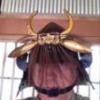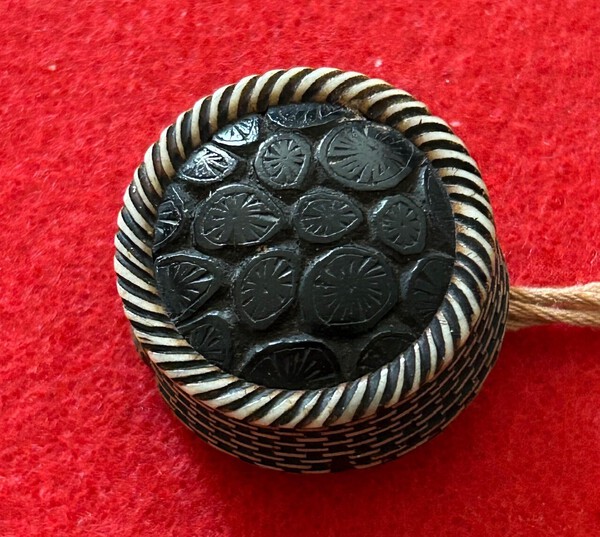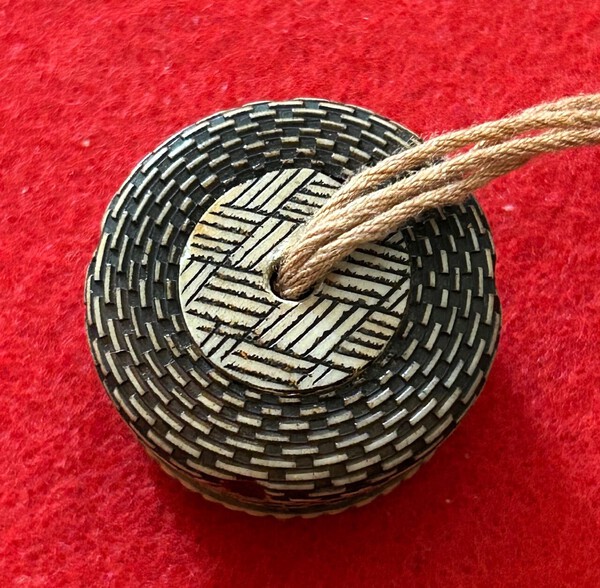-
Posts
14,049 -
Joined
-
Last visited
-
Days Won
257
Content Type
Profiles
Forums
Events
Store
Downloads
Gallery
Everything posted by Bugyotsuji
-
Not a company but an individual ‘kinkō’ metalworker, possibly even of two or three generations. Although prolific, many of these pieces may have come back to certain dealers and collected together over the intervening century. Incidentally I found several different-kanji Yoshiaki artisans, (all sound the same in English, but not the same person) but one -aki using the same 明 character also shortened the left radical, to simply two dots in that case. Pic follows.
-
Agreeing with Colin (Matsunoki) above, sadly, a NLO. (A somewhat better quality Netsuke-like object. Young, so fine for actually wearing today!)
-
At a quick glance it is giving me a feeling of marine ivory, but that's just one opinion. It could be elephant ivory cut from the outer layers in such a way as to to hide any Schreger angles.
-
On the label, 髙橋伊八, Takahashi Ihachi, no?
-

Translation help with a mei and Hozon
Bugyotsuji replied to LastSamurai's topic in Translation Assistance
There is no further information Yuliyan, except that it is designated 'Hozon Token', and the length of the blade is given as: 一尺八寸二分半 "1 shaku, 8 Sun, 2.5 Bu". -
There are plenty of Yari Tanto, (Ken too) but I do not recall having heard the specific expression of Tanto Naoshi, or even Yari Naoshi. Hira-zukuri? Kikuchi yari tanto were also produced though, many in Kyushu. I wonder if that is what he was referring to?
-
Hi John, Uwe above seems to be correct, so I simply gave him a like. Why? Well, many artists would make a subtle change to their signature. 明 should have a 日 on the left but it could be that the choice of 口 was deliberate even if not grammatically correct, i.e. artistic license. At a glance most people would read that Yoshiaki anyway. The clincher would be if you could find other examples signed in the same manner with faint or absent cross bar, but two is already pretty definitive IMO. 草野吉明 Have you checked out for example Kusano Yoshiaki? https://bunka.nii.ac.jp/heritages/detail/198238
-
By extension, the Kusa kanji may be a Mon, for a family name such as Kusanagi.
-

Why is saving for a sword a taboo ?
Bugyotsuji replied to R_P's topic in General Nihonto Related Discussion
While reading these posts I have to keep going back to check what the original question was. Now I am feeling that if you have extra cash, one should invest first and foremost in an old-age pension, ...and if you then still have extra cash, from selling the family silver etc., try not to spend it on wild parties and other stuff, otherwise your sword-purchasing options will be limited. Priorities. -
Sounds like luck of the draw as you say Jeff. Once something flags up, it gets passed around for authorization but no-one knows what to do, and no one is willing to take responsibility for a decision. You have to keep asking, telling them clearly you have the money and you are willing to pay, (otherwise it could end up on a back shelf).
-
What is written on the blade is 豊臣秀吉 Toyotomi Hideyoshi, 1556(?)-1598, for whatever reason, though I am not sure what that first date refers to. As others have said above...
-
Did they stop using Osafune in their Mei? This is something I hadn't considered! Although there were serious floods during the 1500s, during which old Fukuoka Castle was swept away together with many smiths and their workshops, the Yoshii river itself even changing course, Osafune as a place for making swords has continued on to the present day. What I had heard was that when the traditional smiths were washed away, the Sukesada stepped in and finally gained ascendancy in the area. (Edit, thank you M for the explanatory link above, which I have just read.)
-
Interesting idea, Bruce.
-
https://www.e-sword.jp/wakisashi/1810-2005.htm Later (Taisho 10) Kanenori using a Kuyomon.
-
Superb article, Anthony. And you have set a tiny flint, ready to roll!
-
Anthony, welcome indeed! What a wonderful and unique collection! Thank you for sharing these. Each one was surely a Daimyo’s ‘must-have’ latest fashion accessory, a Netsuke with a utilitarian purpose, and a what a great talking point! Were they treasured in a special box, or worn and used as a lighter? I wonder whether there are any written records of their actual usage? That example is not just nice but gorgeous.
-
It describes the life of Fukushima Sensei, to whom the stand was presented.
-

Anyone knows the brand of this factory made wakizashi?
Bugyotsuji replied to Kantaro's topic in Fake Japanese Swords
Could it be upside down, Paris? -
Colin, it was the remaining brown channels from the outside of the frilled antler base. The slight discolouration on the central plug underneath could be either from bone or antler, though. See them in this one too: (sadly no longer mine though)
-
Normally I do not think about blades that are gone, but now that you bring up the subject, there are several. Not actually sure now why I sold them. One was a papered Sue So-Shu tanto in red koshirae with matching shinchu fittings. Every yellow-green part, including the kozuka and wari-kogai was original to the piece, and each part bore the same Mon. I sold it at auction more out of curiosity to see what it would fetch, but it went for almost exactly what I bought it for, and I think it must have then gone over to China. All I gained from the liaison was the sweet memory. Would I ever find something similar again? Now you've got me wishing again that I still had it!
-
PS Be aware that two kanji are used in names for Taka-, the standard 高, and the non-standard 髙.
-
Susudake is funny stuff, and like toast, comes in various shades of burnt. It used to be very expensive some years ago. Perhaps as old farmhouses are getting knocked down there is now more on the market? If you do find examples at antiques fairs, etc., and wish to make your own, make sure to get bamboo with thick enough walls and joints from which to fashion suitably sturdy pegs.
-
The second is a Manju sukashi Netsuke, (sukashi is often called 'Ryusa' in the Netsuke collecting world), hollow and perforated in all directions, openwork. The theme seems to be Kikusui, chrysanthemums and river water, the legend of the Kiku-jido, the boy rejected by his lord, but who was forever faithful. Heavily stained, but under a magnifying glass the material is flecked, not an attribute of the purity of ivory, but more of antler and bone. Made from an antler seat or base. Relatively small in the hand, width 3.99 cm x height 1.48 cm. From top: Underside:
-
Recently I have been sorting through netsuke and making lists of what I have, what I would like to keep, what I should let go of if pressed, what I should keep in one place, and what I might need to split up or move, e.g. take back for a public talk I am giving in Japan in November. While doing this, I thought I should go through the ivory box anyway. A couple of them I showed to someone for input, setting off a debate. The end result is that two of what I thought were ivory have turned out to be stag antler, the material hidden under the carving and staining. There are a couple more that are proving difficult to judge, but just to be on the safe side, those have been popped back in the box. Here are the two clearest examples, which have just been reclassified to stag antler. The first is a basket of sumi charcoal briquettes for the tea ceremony. 3.14 cm wide. Photos of top, side and bottom. Can you see any giveaway signs? And underneath
-
髙田房守 Takada Fusamori ... is what it looks like.















